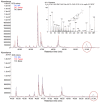The effect of ergosterol on the allogrooming behavior of termites in response to the entomopathogenic fungus Metarhizium anisopliae
- PMID: 35567495
- PMCID: PMC10084151
- DOI: 10.1111/1744-7917.13055
The effect of ergosterol on the allogrooming behavior of termites in response to the entomopathogenic fungus Metarhizium anisopliae
Abstract
Termites have physiological and behavioral immunities that make them highly resistant to pathogen infections, which complicates biocontrol efforts. However, the stimuli that trigger the pathogen-avoidance behaviors of termites are still unclear. Our study shows that workers of Coptotermes formosanus exposed to the conidia of Metarhizium anisopliae exhibited a significantly higher frequency and longer duration of allogrooming behaviors compared with untreated termites. Volatile compounds in the cuticle of control termites and termites previously exposed to a suspension of M. anisopliae conidia were analyzed and compared using a gas chromatography-mass spectrometer (GC-MS). Our results showed that the amount of ergosterol differed between the fungus-exposed and control termites. Choice tests showed that termites significantly preferred to stay on filter paper treated with ergosterol (0.05, 0.1, or 1.0 mg/mL) compared with control filter paper. In addition, termites exposed to ergosterol followed by M. anisopliae conidia were allogroomed at a significantly higher frequency and for a longer duration than termites exposed to alcohol (the solvent used with the ergosterol in the ergosterol trials) alone followed by M. anisopliae conidia. These results showed that ergosterol may enhance the allogrooming behavior of termites in the presence of entomopathogenic fungi.
Keywords: allogrooming behavior; entomopathogenic fungus; ergosterol; recognition; social immunity; termite.
© 2022 The Authors. Insect Science published by John Wiley & Sons Australia, Ltd on behalf of Institute of Zoology, Chinese Academy of Sciences.
Figures





Similar articles
-
Alteration of Termite Locomotion and Allogrooming in Response to Infection by Pathogenic Fungi.J Econ Entomol. 2021 Jun 11;114(3):1256-1263. doi: 10.1093/jee/toab071. J Econ Entomol. 2021. PMID: 33909076
-
Defense mechanism of the termite, Coptotermes formosanus Shiraki, to entomopathogenic fungi.J Invertebr Pathol. 2008 Feb;97(2):165-70. doi: 10.1016/j.jip.2007.09.005. Epub 2007 Sep 14. J Invertebr Pathol. 2008. PMID: 17949740
-
Trichoderma Species Attract Coptotermes formosanus and Antagonize Termite Pathogen Metarhizium anisopliae.Front Microbiol. 2020 Apr 9;11:653. doi: 10.3389/fmicb.2020.00653. eCollection 2020. Front Microbiol. 2020. PMID: 32328057 Free PMC article.
-
The Influence of Allogrooming Behavior on Individual Innate Immunity in the Subterranean Termite Reticulitermes chinensis (Isoptera: Rhinotermitidae).J Insect Sci. 2019 Jan 1;19(1):6. doi: 10.1093/jisesa/iey119. J Insect Sci. 2019. PMID: 30649425 Free PMC article.
-
Prospects for the biological control of subterranean termites (Isoptera: rhinotermitidae), with special reference to Coptotermes formosanus.Bull Entomol Res. 2000 Feb;90(1):9-21. Bull Entomol Res. 2000. PMID: 10948359 Review.
Cited by
-
Subterranean termites raise the alarm when their anti-fungal weapon falters.Naturwissenschaften. 2023 Dec 27;111(1):1. doi: 10.1007/s00114-023-01887-0. Naturwissenschaften. 2023. PMID: 38150102
-
Cross-talk between immunity and behavior: insights from entomopathogenic fungi and their insect hosts.FEMS Microbiol Rev. 2024 Jan 12;48(1):fuae003. doi: 10.1093/femsre/fuae003. FEMS Microbiol Rev. 2024. PMID: 38341280 Free PMC article. Review.
-
Pathogen evasion of social immunity.Nat Ecol Evol. 2023 Mar;7(3):450-460. doi: 10.1038/s41559-023-01981-6. Epub 2023 Feb 2. Nat Ecol Evol. 2023. PMID: 36732670 Free PMC article.
-
Dynamic pathogen detection and social feedback shape collective hygiene in ants.Nat Commun. 2023 Jun 3;14(1):3232. doi: 10.1038/s41467-023-38947-y. Nat Commun. 2023. PMID: 37270641 Free PMC article.
References
-
- Bates, D. , Maechler, M. , Bolker, B. and Walker, S. (2015) Fitting linear mixed‐effects models using lme4. Journal of Statistical Software, 67, 1‒48.
-
- Chouvenc, T. and Su, N.Y. (2010) Apparent synergy among defense mechanisms in subterranean termites (Rhinotermitidae) against epizootic events: limits and potential for biological control. Journal of Economic Entomology, 103, 1327‒1337. - PubMed
MeSH terms
LinkOut - more resources
Full Text Sources
Miscellaneous

